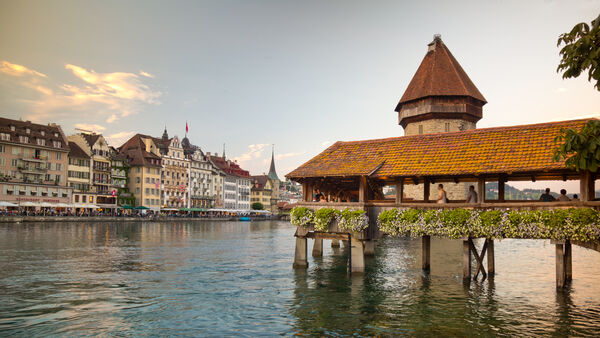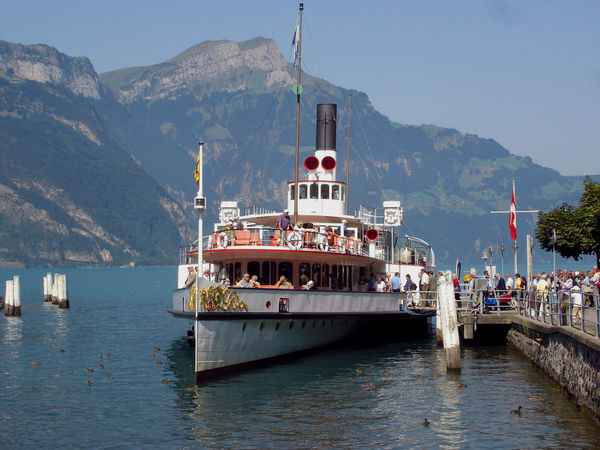Luzern’s Swiss Mix of Delights
By Rick Steves

Pretty, pristine, and lakeside, and at the foot of a towering hulk of a mountain, Luzern has long been Switzerland's tourism capital. Since the Romantic era in the 19th century, it's been a regular stop on the "Grand Tour" of Europe for the likes of Mark Twain and Queen Victoria. And with a charming old town, a gaggle of fine museums, and proximity to Mount Pilatus and its fun alpine activities, there's still enough in Luzern to earn it a place on any Swiss itinerary.
Luzern offers an enticing, I-could-live-here glimpse of the appealing and uniquely Swiss urban quality of life. Efficient buses glide around town, pedestrian bridges span the crystal-clear river, and an array of cruise boats ply scenic Lake Lucerne.
Simply wandering the city's clean streets, strolling its bridges, and cruising the lake is enough for a happy day of sightseeing. But Luzern also offers some fine attractions. Art buffs flock to the Rosengart Collection for its Picasso exhibit, gearheads have a ball at the Swiss Transport Museum, and rock hounds dig the city's Glacier Garden.
Luzern began as a fishing village at the spot where the Reuss River tumbles out of Lake Lucerne. By the 13th century, with traffic between northern and southern Europe streaming through the nearby Gotthard Pass, the city became a bustling trading center. All that traffic brought the construction of two covered wooden river bridges that are now Luzern icons.
In the 14th century, the Chapel Bridge (Kapellbrücke) was oddly built across the river — spanning its banks at an angle to connect the town's fortifications. Under its rafters hang about 100 colorful 17th-century paintings showing contemporary and historic scenes, including landscapes of Luzern as it looked in about 1400, portraits of the city's two patron saints, and a depiction of a giant from a medieval legend that arose here when locals misidentified newly discovered mammoth bones as human.
The other famous bridge — Mill Bridge (Spreuerbrücke) — also has fine 17th-century paintings, which show Luzern's favorite giant again, with the blue-and-white city and cantonal banners under the double eagle of the Holy Roman Empire — a reminder that the emperor granted free status to the city. The flip side shows Judgment Day, with some going to heaven and others to hell.
Another emblematic sight is the Lion Monument. This free, famous memorial is an essential stop if you're visiting Luzern — if only because when you get back home, everyone will ask you, "Did you see the lion?" Open from sunrise to dusk, the huge sculpture (33 feet long by 20 feet tall) is carved right into a cliff face, over a reflecting pool in a peaceful park.
Though it's often overrun with tour groups, a tranquil moment here is genuinely moving: The mighty lion rests his paws on a shield, with his head cocked to one side, tears streaming down his cheeks. In his side is the broken-off end of a spear, which is slowly killing the noble beast. (The angle of the spear matches the striations of the rock face, subtly suggesting more spears raining down on the lion.) This heartbreaking figure represents the Swiss mercenaries who were killed or executed defending the French king in the French Revolution. The inscription reads, "Helvetiorum fidei ac virtuti" — "To the loyalty and bravery of the Swiss."
Along with its historic landmarks, Luzern also has distinctive modern architecture. On the waterfront is a huge boxy building with a big, flat overhanging roof — the Luzern Culture and Conference Center. Lake water is pumped up, into, through, and out of this building; if you wander around its far side, you'll see open channels that go right through the middle of the structure.
One of the best ways to experience Luzern is by boat. The turquoise waters of Lake Lucerne (or the "Vierwaldstättersee" to locals), with a total area of 44 square miles, reflect a different angle of the surrounding scenery — with its jagged mountaintops and green foothills — at every turn. Cruise boats cover a variety of routes and destinations (35 stops in all), ranging from a one-hour sampler tour around Luzern's "harbor" to a full-blown, six-hour exploration to the far end of the lake and back. Some routes are round-trip dinner or sightseeing cruises, but most boats have scheduled stops and are designed for you to get out, explore, and then take the next boat back. Romantics will want to hitch a ride on one of the old-fashioned paddleboat steamers.
From its dramatic scenery and quaint wooden bridges to its modern, urban efficiency, Luzern is one of Switzerland's gems. Among Switzerland's engaging cities, Luzern sparkles as perhaps the brightest of all.

